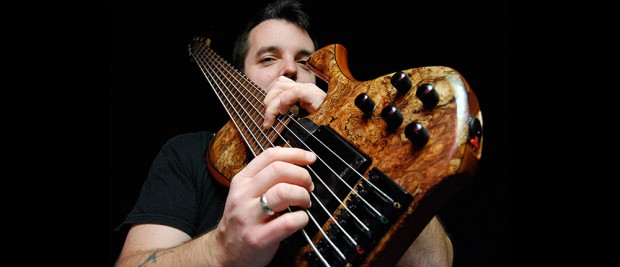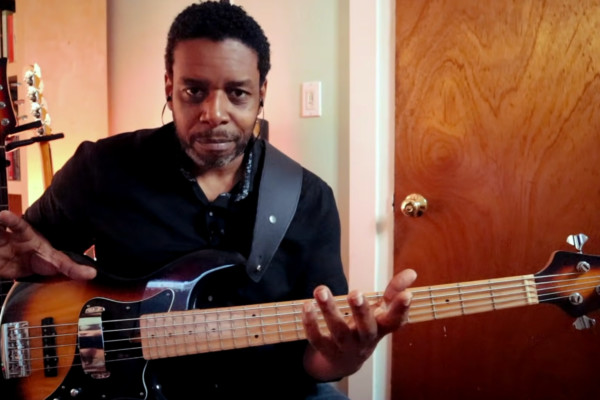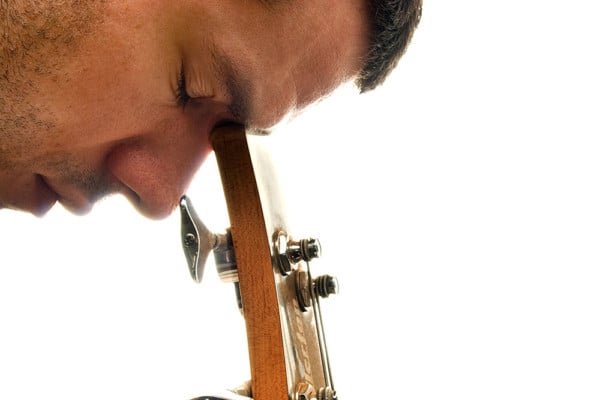Reader Question Roundup: Legato Playing, Short Practice Schedules and Playing Complex Music

I’m sitting in my hotel room in Lincoln, Nebraska and sifting through my file with all the questions submitted by readers I have yet to answer.
Three of them were short enough to put together a “reader question roundup”. I thought this would be a nice change of pace – and one that would allow me to answer important questions which wouldn’t fill a typical column.
(By the way, please send me more questions: [email protected]).
Q: I’m struggling with playing legato with one finger across strings – i.e. fourth or minor seventh – it always sounds staccato and it always puts me off a little bit. My teacher keeps telling me I should slide across the strings, but that usually produces some unwanted sounds. Any suggestion how to practice to overcome this obstacle?
A: With any small technical challenge – whether it’s playing staccato, legato, slurring, bending or any other articulation – I suggest practicing it in a slow, methodical way. It sounds like you just need to explore the mechanics of what you are trying to do.
I tend to roll my finger in the direction I am traveling across the strings. To roll from a lower pitched string to a higher pitched string, I would pick a fret and practice slowly and methodically playing one note with the tip of my finger and then slowly roll it back and see if you can get one note to bump up against the note sonically. Be careful not to pull on the string, as you don’t want to bend the pitch. Instead, simply roll your finger from tip to knuckle. You likely won’t be able to do it across more than a string or two without compromising your tone a little bit but you can even get it to work fairly well over 4 strings or so if you’re careful. Much likely depends upon your hand position. I tend to play with a good curve in my fingers. Imagine that you are gripping a baseball in your hand – or holding an apple – and visualize your fingers wrapping around that sphere. That is the position that I usually keep my left hand in (similar to a classical guitarist, actually). When you roll your finger back, it will be almost like your finger is doing the worm (dated 80’s breakdancing reference alert).
Doing this from a higher pitched string to a lower pitched string would require that you fret the first note with the meat in between knuckles and roll forward to towards the tip of your finger.
There is no one way to do it correctly, and it really is all about your own physiology and what will work to produce the sound you want. So it will take some experimentation, but I have yet to find anything that I couldn’t tackle technically with a little thought and exploration. Just keep messing with it. You’ll get it!
Q: I’m a student and I try to practice between classes when I can, but I’ve come to a stand still. Are there any methods that you would recommend? I know the major and the majority of the minor scales, so more of just a way to help integrate my knowledge into my playing.
A: As I’ve said before, there are no shortcuts to anything. It is truly all about time plus attention to detail. I know that you didn’t ask for a shortcut but the following is the only thing that came to mind.
The only way to better integrate anything into your playing is to do it over and over again until you internalize it. Scales aren’t really much beyond a general guide to tonality and a way to practice playing in a specific key on your instrument. Scales are a tool in the shed, but they don’t really apply to making music in real life beyond that as a guide to tonality.
It honestly sounds like you need to more fully explore the relationships between the scales by practicing them all (every mode) in multiple positions and moving in multiple directions on the fretboard. Explore them as an improvisor as well. Practice soloing in one key over a sustaining chord and then try to use any and all of the other related modes instead of just that one parent scale.
For example, play over a C Major chord first by using the C Major scale, but then try improvising using the relative minor scale (A minor – same notes as C Major, just starting from a different root).
Then try all of the other modes. Then try to move between them, switching modes as you play (play a few bars of C Major and then move to playing in E Phrygian and so on).
Also, transcribe music! Transcribe lines that others have played note-for-note, and really analyze them and try and see what they were doing or thinking when they played them.
Learn melodies to tons of songs and explore how they relate to the scales.
Always try and consider a new perspective and think about how you can take this one thing that you know well and turn it on it’s head (i.e.: ok, so you know the major scale. Can you play it on only one string? Can you play it from the lowest note on your bass to the highest over multiple octaves without pausing to think about it? and so on).
Keep pushing yourself to turn what you know into a new exercise. Teaching yourself how to think creatively when you practice is a big step towards thinking creatively when you make music!
Q: My friend (who is a guitarist) and I are starting a new project that will be focused around technical instrumental music – really complicated stuff. Technically speaking, he is light years ahead of me, so I wanted your opinion and experience on when should we “double” the thing others are doing, like a second guitarist almost, and when should just relax and maybe even stay in the groove?
A: My short answer is, “when it sounds like you should”. Every style of music wants something different, and there are no rules or limits. I always suggest that you really listen to the music and try to hear what it wants from you. I would record a rehearsal and try things both ways. Then listen back and A/B the two approaches. Which one has more impact?
Don’t get caught up in the “look at what I did there!” thing, but go for what makes the tune feel stronger and sounds good.
And, since you mentioned being less technically capable than the guitarist, make sure that if you do double a line that you are playing the hell out of it. If you can’t pull it off, bail on it and provide a solid foundation. Nothing ever sounded worse because the bass player kept playing a solid bass line.
Have a question for Damian Erskine? Send it to [email protected]. Check out Damian’s instructional books, Right Hand Drive and The Improviser’s Path.



